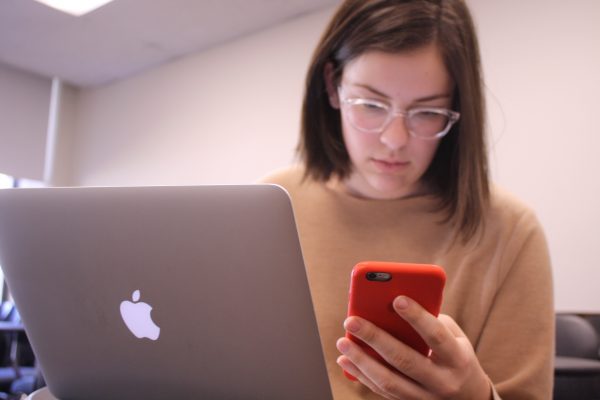Preventing Digital Eye Strain
FCLC ’19 student Hailey Morey demonstrating how often we look at our screens in Lowenstein on March 22, 2017. (BROOKE PARRETT/THE OBSERVER).
April 20, 2017
Digital devices permeate just about every aspect of the American life. Blue light, also known as high energy visible (HEV) light, is the light that is emitted from the screens of many technological devices and gadgets such as computers, phones and televisions. Blue light has the ability to penetrate deep into the eye, even further than ultraviolet light, which may cause damage to the eye’s retina. A much more common result, however, is eye strain, which heightens the risk of severe eye damage.
Digital eye strain is a common condition that many people encounter after staring at bright screens that emit blue light for long periods of time. As the use of technology increases, eye strain is becoming more prevalent. According to The Vision Council, more than 87 percent of Americans report using digital devices for more than two hours each day. Moreover, the Modern Medicine Network reports that approximately 28 percent of people spend 10 or more hours in front of digital devices daily.
This excessive screen time puts the eyes of individuals under undue stress, potentially causing irreversible damage to the eyes.
Now more than ever, people want to connect and be a part of the global, social network, yet they don’t realize how much they are jeopardizing their eyes as a result. One’s eyes are the windows to the world and are one of the most vital organs of the human body. The consequences of eye damage are life-altering. It is imperative to care for the eyes, starting with preventing eye strain.
Students are particularly subject to digital eye strain as they spend an immense amount of time in front of bright screens and on electronic devices. Not only is this generation the most technological one yet, but simply being a college student entails using computers to perform research and typing essays, both of which are technologically dependant.
Research is even deeming final exams detrimental to eye health because of the strain studying puts on them (which may be good news for students). The technology-heavy studying sessions, generally combined with sleeplessness and unhealthy eating habits, prove harmful to not only one’s eyes, but one’s body as well. Blue light exposure, especially at night, can lead to further sleeplessness as it suppresses one’s melatonin levels, making it more difficult to fall and stay asleep. As students are constantly reminded, a restful night is key to maximizing performance on major exams.
Symptoms of eye strain include eye fatigue and irritation, neck pain, sleep disruption and headaches. However, these symptoms are not only restricted to younger people. According to Dr. Joan Roberts Ph.D, Professor of Chemistry at Fordham College at Lincoln Center (FCLC), the risk of eye damage heightens as one ages.
She stated, “When over 50, because of changes in the chemistry of the human eye, the damage is the induction of cataracts and macular degeneration.” Eye strain doesn’t result in immediate eye damage, but rather becomes a larger problem with the continued use of blue light devices as one ages. For instance, with cumulative and constant exposure, the retinal cells in the eye can be damaged. The retina is a light-sensitive tissue, often considered the most important part of the eye as it transforms light into visual images. Once damaged, the retina cannot be repaired, so protecting the eyes from blue light is a great way to prevent retinal damage as well as damage to other parts of the eye.
Despite the fact that digital wonders will always be taxing on our eyes, there are many measures that one can take to help prevent eye strain. Individuals can follow the 20-20-20 rule which entails taking a break every 20 minutes to focus on something (not another screen) 20 feet away, for 20 seconds. Additionally, one should sit a good distance from the screen, lessening the amount of strain on the eyes. Lastly, Dr. Roberts advises putting a yellow filter over the screen of the device, or getting an app that changes the background of the screen to removes the blue light, especially after sunset in an effort to avoid sleep disruption. Appointments can also be made with an opthamologist who evaluate the symptoms of digital eye strain and recommend either lifestyle changes or alternate lenses to improve eye health.













Dimitri Johnson • May 15, 2017 at 4:30 pm
I think I may have strained my right eye some years back, because the vision in my left eye is much clearer than my right.